
Oleg
Matsevich
Hardscape
Description
Hi Friends.
Herein I am presenting my experiments in producing of creeping fog in an aquarium. In the photo you can see really misty lowland. Usually, when aquarists want to show a waterfall in an aquarium, they use sand or synthetic winterizer. However, these materials do not look natural they are more suitable for decorating an amateur aquarium (beginner aquarist), but not for professional aquascape artist. So, you can imagine the difficulties involved in producing of fog in the aquarium
To implement the idea, I needed to find a substance that would be heavier than water and creates a haze-suspension under water similar to natural fog. Furthermore, this substance shouldbe inert and not dissolve in water, thus creating just a muddy aquarium. In addition, this substance must be safe for all aquatic ecosystem (fish, shrimp, snails and plants).
And I think I have found such a material. This substance is amorphous silicon dioxide. The silicon dioxide slurry is perfect for creating a fog-like effect in an aquarium.
It is absolutely safe, and it has found wide application in human life. It is used as a dietary supplement in cattle industry, as well as medicine. For example, in Russian Federation and USA, there is a pharmaceutical preparation called "Polisorb" - this is an enterosorbent that removes toxins from the human body in case of poisoning and relieves minor digestive discomfort. Polisorb is nothing more than colloidal silicon dioxide. Silicon dioxide is also added to the composition of the aquarium tablets. Many of the aquarium fertilizers tablets contain silicon dioxide, which allows the tablet to retain its shape when wet and thus slow release the nutrients for aquarium plants.
I have carried out numerous experiments in an empty aquarium, as well as in an aquarium with a hardscape (without plants and fish) to study the physics of this Silicon dioxide fog. I have tried to understand how this fog behaves and moves around under water. These experiments have given me the ability to control the fog.
Over a period of 6 months I have experimented numerous times, throwing fog into an already operating aquarium with fish, shrimps and plants. This finally convinced me that my fog creates a beautiful mesmerizing effect in the aquarium and that my idea is viable. The aquatic fauna and flora had no adverse effect from the imitation of fog. On the contrary, it even seems to me that due to the light silting of the soil, the nitrification processes have improved. Since a finely dispersed suspension of silicon dioxide is an excellent substrate for the settlement of colonies of beneficial microorganisms, which in turn remove nitrogenous poisons from the aquarium. Unfortunately I have no proof of this hypothesis However the fish and plants thrived very well during the entire time.
Fog, as a natural phenomenon, is beautiful. Fog creates magnificent silhouettes, the outlines of everything that it surrounds. But since details are important in aquascaping, the viewer should be able to see the aquascape of the underwater world through the fog.
With that said, the biggest challenge was keeping the balance between the creeping fog and the aquarium composition itself. And it seems to me that I achieved the goal. If you look at my work - this is a classic modern volumetric (3D) aquarium model with aquatic plants. Everything is visible in it, a lot of details, and the creeping fog only pleasantly envelops the plants at the bottom of the aquarium. It turned out naturally, very similar to how the fog behaves in meadows, lowlands or in hollows.
As for technical manipulations, a suspension of silicon dioxide can be introduced into the aquarium by a syringe or through tubes previously drawn along the bottom of the aquarium. The underwater fog lasts for about 2 hours, then the suspension settles at the bottom. The suspension may also be added via an automatic dispenser.
Removing fog from an aquarium is also easy. This can be done with a small water change and/or using a coagulant.
Herein I am presenting my experiments in producing of creeping fog in an aquarium. In the photo you can see really misty lowland. Usually, when aquarists want to show a waterfall in an aquarium, they use sand or synthetic winterizer. However, these materials do not look natural they are more suitable for decorating an amateur aquarium (beginner aquarist), but not for professional aquascape artist. So, you can imagine the difficulties involved in producing of fog in the aquarium
To implement the idea, I needed to find a substance that would be heavier than water and creates a haze-suspension under water similar to natural fog. Furthermore, this substance shouldbe inert and not dissolve in water, thus creating just a muddy aquarium. In addition, this substance must be safe for all aquatic ecosystem (fish, shrimp, snails and plants).
And I think I have found such a material. This substance is amorphous silicon dioxide. The silicon dioxide slurry is perfect for creating a fog-like effect in an aquarium.
It is absolutely safe, and it has found wide application in human life. It is used as a dietary supplement in cattle industry, as well as medicine. For example, in Russian Federation and USA, there is a pharmaceutical preparation called "Polisorb" - this is an enterosorbent that removes toxins from the human body in case of poisoning and relieves minor digestive discomfort. Polisorb is nothing more than colloidal silicon dioxide. Silicon dioxide is also added to the composition of the aquarium tablets. Many of the aquarium fertilizers tablets contain silicon dioxide, which allows the tablet to retain its shape when wet and thus slow release the nutrients for aquarium plants.
I have carried out numerous experiments in an empty aquarium, as well as in an aquarium with a hardscape (without plants and fish) to study the physics of this Silicon dioxide fog. I have tried to understand how this fog behaves and moves around under water. These experiments have given me the ability to control the fog.
Over a period of 6 months I have experimented numerous times, throwing fog into an already operating aquarium with fish, shrimps and plants. This finally convinced me that my fog creates a beautiful mesmerizing effect in the aquarium and that my idea is viable. The aquatic fauna and flora had no adverse effect from the imitation of fog. On the contrary, it even seems to me that due to the light silting of the soil, the nitrification processes have improved. Since a finely dispersed suspension of silicon dioxide is an excellent substrate for the settlement of colonies of beneficial microorganisms, which in turn remove nitrogenous poisons from the aquarium. Unfortunately I have no proof of this hypothesis However the fish and plants thrived very well during the entire time.
Fog, as a natural phenomenon, is beautiful. Fog creates magnificent silhouettes, the outlines of everything that it surrounds. But since details are important in aquascaping, the viewer should be able to see the aquascape of the underwater world through the fog.
With that said, the biggest challenge was keeping the balance between the creeping fog and the aquarium composition itself. And it seems to me that I achieved the goal. If you look at my work - this is a classic modern volumetric (3D) aquarium model with aquatic plants. Everything is visible in it, a lot of details, and the creeping fog only pleasantly envelops the plants at the bottom of the aquarium. It turned out naturally, very similar to how the fog behaves in meadows, lowlands or in hollows.
As for technical manipulations, a suspension of silicon dioxide can be introduced into the aquarium by a syringe or through tubes previously drawn along the bottom of the aquarium. The underwater fog lasts for about 2 hours, then the suspension settles at the bottom. The suspension may also be added via an automatic dispenser.
Removing fog from an aquarium is also easy. This can be done with a small water change and/or using a coagulant.
